Chinese
Matrimony Vine
Lycium chinense
Nightshade family (Solanaceae)
Lycium chinense
Nightshade family (Solanaceae)
Description:
This multi-stemmed deciduous shrub is typically 1–4' tall and similarly
across, sometimes becoming even larger in size. The woody stems and
shoots are ascending, arching, or sprawling, and they sometimes climb
over adjacent vegetation and objects like a vine. Older woody stems
tend to be brown, terete, and thorny, while younger woody stems are
light brown with whitish streaks, terete or 4-angled, and either
thornless or thorny. The thorns are up to ½" long or slightly longer.
Young green shoots are light green, terete or 4-angled, hairless, and
usually thornless. Leaves occur along the young shoots or young woody
stems; primary leaves are alternate, but secondary leaves occur in
clusters from the axils of older primary leaves.
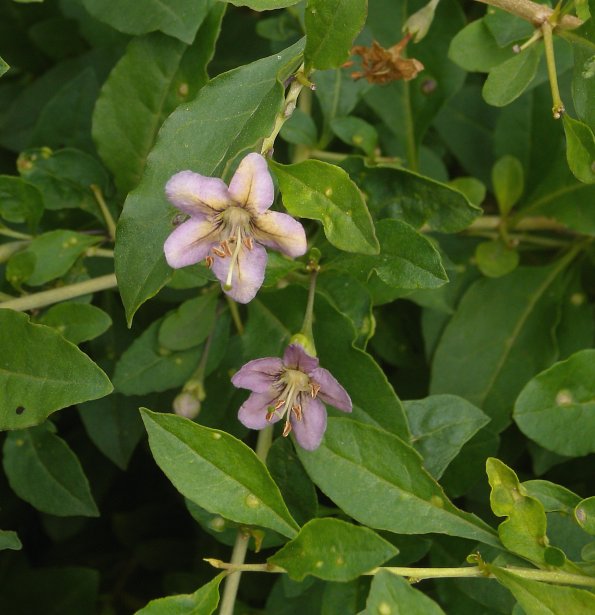
These leaves are ¾–2" long and ¼–¾" across; they are elliptic to broadly elliptic in shape and toothless along their margins. The tips of these leaves are acute or blunt, while their bottoms taper into short petioles that are partially winged. The upper leaf surface is grayish green or medium green and hairless, while the lower leaf surface is pale grayish green or pale green and hairless. Solitary or clusters of 2–3 flowers occur from the axils of leaves on hairless light green petioles about ¼–¾" long. Each flower is about ¾" long and similarly across, consisting of a bell-shaped (campanulate) light green calyx with 3–5 teeth, a lavender corolla with 5 spreading rounded lobes, 5 exserted stamens with brownish anthers, and an ovary with a single exserted white style that terminates in a swollen light green stigma. The base of each corolla is short tubular-funnelform; it is about the same length or a little shorter than its spreading lobes. The throat of the corolla and the interior of its lobes have dark pinnate and radiating veins, and sometimes the area around these veins is pale with light brown, yellowish, or greenish tints.
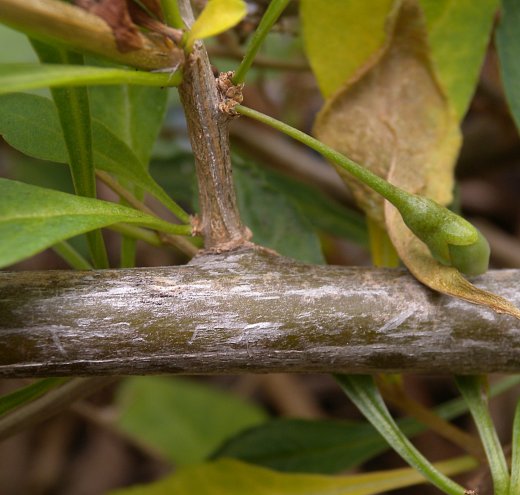
The blooming period occurs during the summer and into the autumn, lasting about 2–3 months. If a shrub is fertile, the majority of the flowers will be replaced by orange-red to red berries that are ¼–½" long, ovoid in shape, hairless, and shiny. The interior of these berries is reddish and juicy; each berry contains about 10–20 seeds. Individual seeds are about 1 mm. in diameter, orbicular-coiled in shape, somewhat flattened, and brownish yellow. The root system is woody and branching. This shrub can reproduce asexually by layering (forming new shoots when older branches or shoots become embedded in soil), or by reseeding itself.
Cultivation: The preference is full or partial sun, well-drained conditions, and areas with sparse ground vegetation. This low shrub adapts to a wide range of soil types, including loam, sand, and gravel with a pH range of 6–8. It is hardy to Zone 4.
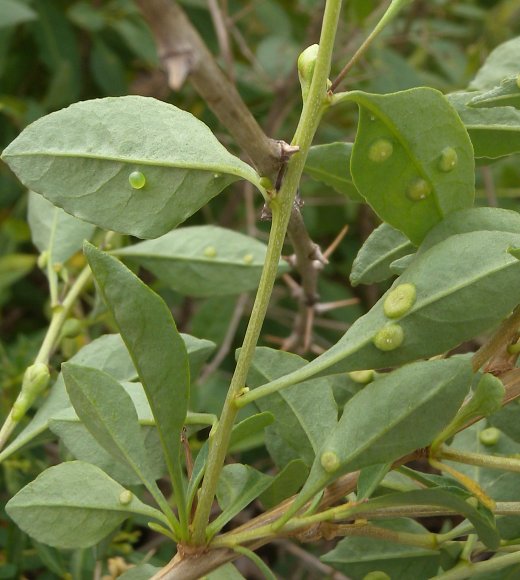
Range & Habitat: So far, the non-native Chinese Matrimony Vine has been observed to naturalize in only 3 counties in central Illinois (see Distribution Map), where it is rare. However, its actual occurrence in the wild is probably more common than this. This shrub is native to east Asia. Habitats include old homestead sites, roadsides, areas along railroads, vacant lots, and waste areas. Habitats with a history of disturbance are preferred. Chinese Matrimony is uncommonly cultivated as a garden plant, particularly for its berries, which reputedly have medicinal value. Cultivars have been developed that tend to produce abundant larger berries for this purpose; they are common referred to as the Goji Berry Plant, although sometimes such plants are the very similar Common Matrimony Vine (Lycium barbarum), which is also from east Asia.
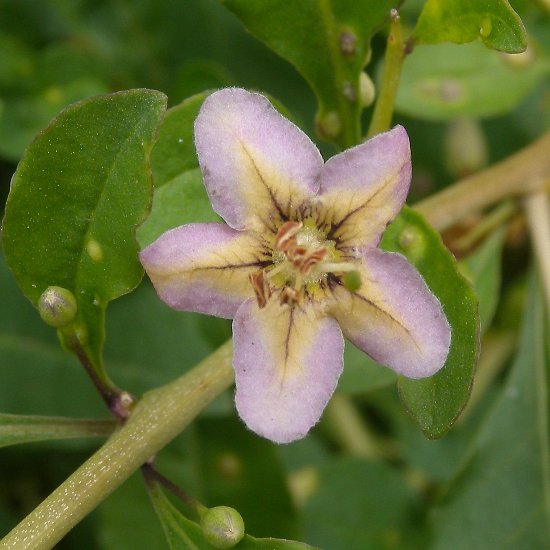
Faunal Associations: The flowers are probably cross-pollinated primarily by bumblebees and other long-tongued bees. The Chinese Matrimony Vine (Lycium chinense) and the very similar Common Matrimony Vine (Lycium barbarum) are often attacked by the Goji Berry Gall Mite (Aceria kuko), which forms large galls on their leaves; these galls have an orbicular-flattened shape. Other insects that may occasionally feed on these shrubs include the Cotton Mealybug (Phenacoccus solenopsis), Potato Aphid (Macrosiphum euphorbiae), Colorado Potato Beetle (Leptinotarsa decemlineata), Potato Flea Beetle (Psylliodes affinis), Tomato Hornworm (Manduca quinquemaculata), and Tobacco Hornworm (Manduca sexta); see CABI website (2019), Pepper (1965), Clark et al. (2004), and Natural History Museum website (2010). The berries are probably eaten by some birds, which would help to spread these shrubs to new locations.
Photographic Location: A waste area along a railroad in Urbana, Illinois.
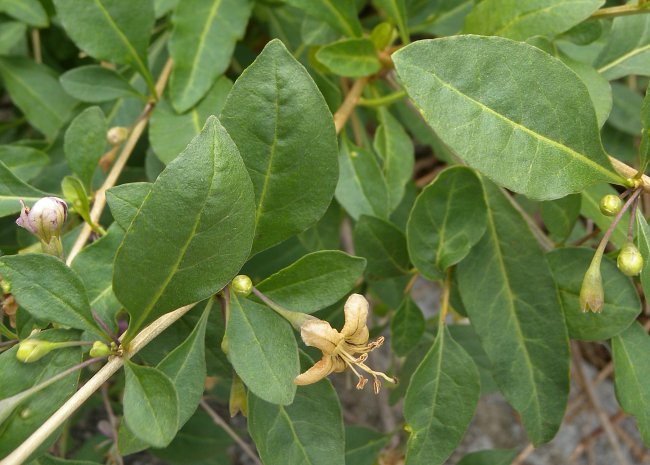
Comments: Chinese Matrimony Vine (Lycium chinense) has a rather untidy look because its woody stems and shoots have a tendency to arch and spread in different directions. Even though it is referred to as a "vine" in its common name, this plant is really more like a shrub. Other common names for this plant include Chinese Goji Berry, Chinese Wolfberry, Chinese Box-thorn, and Chinese Desert-thorn. Chinese Matrimony Vine is very similar in appearance to Common Matrimony Vine (Lycium barbarum) and distinguishing these two species can be tricky. Chinese Matrimony Vine tends to have shorter pedicels, calyces with 3–5 teeth rather than 2 teeth, corolla lobes that are as long or slightly longer than the corolla tube of a flower rather than shorter, and more fine pubescence along the margins of its corolla lobes. Both of these woody shrubs have naturalized in Illinois, although Common Matrimony Vine is slightly more abundant. Both species have been found in other parts of the United States, especially in the eastern one-half of the country.

These leaves are ¾–2" long and ¼–¾" across; they are elliptic to broadly elliptic in shape and toothless along their margins. The tips of these leaves are acute or blunt, while their bottoms taper into short petioles that are partially winged. The upper leaf surface is grayish green or medium green and hairless, while the lower leaf surface is pale grayish green or pale green and hairless. Solitary or clusters of 2–3 flowers occur from the axils of leaves on hairless light green petioles about ¼–¾" long. Each flower is about ¾" long and similarly across, consisting of a bell-shaped (campanulate) light green calyx with 3–5 teeth, a lavender corolla with 5 spreading rounded lobes, 5 exserted stamens with brownish anthers, and an ovary with a single exserted white style that terminates in a swollen light green stigma. The base of each corolla is short tubular-funnelform; it is about the same length or a little shorter than its spreading lobes. The throat of the corolla and the interior of its lobes have dark pinnate and radiating veins, and sometimes the area around these veins is pale with light brown, yellowish, or greenish tints.

The blooming period occurs during the summer and into the autumn, lasting about 2–3 months. If a shrub is fertile, the majority of the flowers will be replaced by orange-red to red berries that are ¼–½" long, ovoid in shape, hairless, and shiny. The interior of these berries is reddish and juicy; each berry contains about 10–20 seeds. Individual seeds are about 1 mm. in diameter, orbicular-coiled in shape, somewhat flattened, and brownish yellow. The root system is woody and branching. This shrub can reproduce asexually by layering (forming new shoots when older branches or shoots become embedded in soil), or by reseeding itself.
Cultivation: The preference is full or partial sun, well-drained conditions, and areas with sparse ground vegetation. This low shrub adapts to a wide range of soil types, including loam, sand, and gravel with a pH range of 6–8. It is hardy to Zone 4.

Range & Habitat: So far, the non-native Chinese Matrimony Vine has been observed to naturalize in only 3 counties in central Illinois (see Distribution Map), where it is rare. However, its actual occurrence in the wild is probably more common than this. This shrub is native to east Asia. Habitats include old homestead sites, roadsides, areas along railroads, vacant lots, and waste areas. Habitats with a history of disturbance are preferred. Chinese Matrimony is uncommonly cultivated as a garden plant, particularly for its berries, which reputedly have medicinal value. Cultivars have been developed that tend to produce abundant larger berries for this purpose; they are common referred to as the Goji Berry Plant, although sometimes such plants are the very similar Common Matrimony Vine (Lycium barbarum), which is also from east Asia.

Faunal Associations: The flowers are probably cross-pollinated primarily by bumblebees and other long-tongued bees. The Chinese Matrimony Vine (Lycium chinense) and the very similar Common Matrimony Vine (Lycium barbarum) are often attacked by the Goji Berry Gall Mite (Aceria kuko), which forms large galls on their leaves; these galls have an orbicular-flattened shape. Other insects that may occasionally feed on these shrubs include the Cotton Mealybug (Phenacoccus solenopsis), Potato Aphid (Macrosiphum euphorbiae), Colorado Potato Beetle (Leptinotarsa decemlineata), Potato Flea Beetle (Psylliodes affinis), Tomato Hornworm (Manduca quinquemaculata), and Tobacco Hornworm (Manduca sexta); see CABI website (2019), Pepper (1965), Clark et al. (2004), and Natural History Museum website (2010). The berries are probably eaten by some birds, which would help to spread these shrubs to new locations.
Photographic Location: A waste area along a railroad in Urbana, Illinois.

Comments: Chinese Matrimony Vine (Lycium chinense) has a rather untidy look because its woody stems and shoots have a tendency to arch and spread in different directions. Even though it is referred to as a "vine" in its common name, this plant is really more like a shrub. Other common names for this plant include Chinese Goji Berry, Chinese Wolfberry, Chinese Box-thorn, and Chinese Desert-thorn. Chinese Matrimony Vine is very similar in appearance to Common Matrimony Vine (Lycium barbarum) and distinguishing these two species can be tricky. Chinese Matrimony Vine tends to have shorter pedicels, calyces with 3–5 teeth rather than 2 teeth, corolla lobes that are as long or slightly longer than the corolla tube of a flower rather than shorter, and more fine pubescence along the margins of its corolla lobes. Both of these woody shrubs have naturalized in Illinois, although Common Matrimony Vine is slightly more abundant. Both species have been found in other parts of the United States, especially in the eastern one-half of the country.